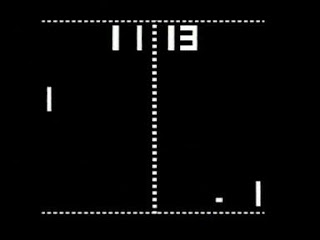One of the first gaming systems to become hugely popular on the market was the game Pong (released in 1975) by Atari. This was a gaming console that included one game, an arcade style game where you bounced a ball back and forth between paddles. While (as you can see in the screen shot below) the graphics were incredibly basic, and it was a simple concept, it was, however, revolutionary for it's time as it contained a single chip that could both produce the score on the screen, and produce the sounds of the game. Beyond this, it also peaked the public's interest in home gaming systems, making a pathway in the industry for expansion.

In 1985 Nintendo released their first gaming console, the Nintendo Entertainment System (NES), and though there had been other gaming systems on the market for several years (notably, Atari, Intellivision, and Odyssey), this was the first system of it's kind to popularise platform gaming with the introduction of the Super Mario Bros. genre. The first releases of this game included pixelated yet colourful graphics and catchy music which even today is still known for being linked to this series of games.

This and many other popular games were re-released when the first Game Boy was introduced in 1989, the first portable gaming system on the market. While Super Mario Bros. was available on this platform, the release of Tetris is what really made the sales of Game Boy skyrocket. While the original Game Boy was quite large and only in black and white later releases saw more compact and colour versions hit the market.
At this stage, the graphics in games were still quite simple and pixelated, even those in later releases of the systems, and it wasn't until the release of the Sony PlayStation in 1995 that we began to see more refined graphics in the world of gaming.

Until this release, the Super Nintendo gaming system was the most popular console on the market, and to keep up with the Sony PlayStation they released the Nintendo 64 in 1996, which featured far superior graphics to it's predecessors'. As you can see by comparing the photo below and the above photos representing the original Super Mario Bros. game, despite the fact that it was basically the exact same game concept, the graphics were significantly improved.

Since then, electronic game graphics have only improved further and since the release of the Playstation 3 and xbox, arguably the two most popular consoles available today. With each game release new technology is being put to use to create even more realistic worlds for avid gamers to lose themselves in.


Currently the gaming world is working on 3D games, which will only further revolutionise the industry, and prove that the gaming world has come a long was since the invention of Pong back in 1975.
References:
Enhance N64 Graphics With Emulation Plugins & Texture Packs | RetroGaming with Racketboy. 2011. Enhance N64 Graphics With Emulation Plugins & Texture Packs | RetroGaming with Racketboy. [ONLINE] Available at:http://www.racketboy.com/retro/nintendo/n64/2008/03/enhance-n64-graphics-with-emulation-plugins-texture-packs.html. [Accessed 29 September 2011].
A History of Video Game Consoles - TIME. 2011. A History of Video Game Consoles - TIME. [ONLINE] Available at:http://www.time.com/time/interactive/0,31813,2029221,00.html. [Accessed 29 September 2011].
The Super Mario Brothers Quiz « Lightly Salted Trivia Quiz Game. 2011. The Super Mario Brothers Quiz « Lightly Salted Trivia Quiz Game. [ONLINE] Available at:http://www.litelysalted.com/2010/09/the-super-mario-brothers-quiz/. [Accessed 29 September 2011].
The Video Game Critic's Wii Reviews G-L. 2011. The Video Game Critic's Wii Reviews G-L. [ONLINE] Available at: http://videogamecritic.net/wiigl.htm. [Accessed 29 September 2011].
No comments:
Post a Comment